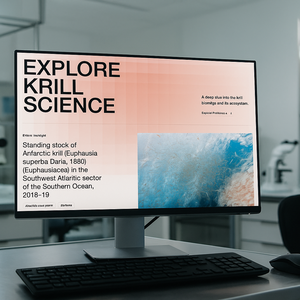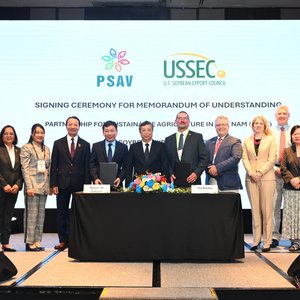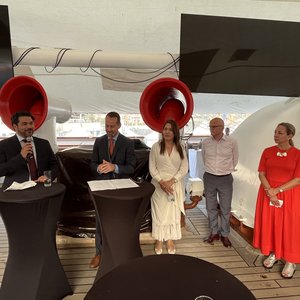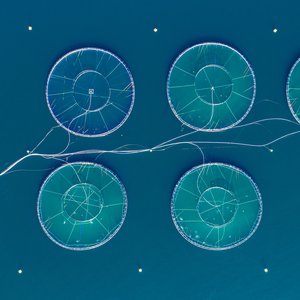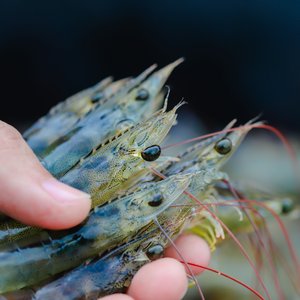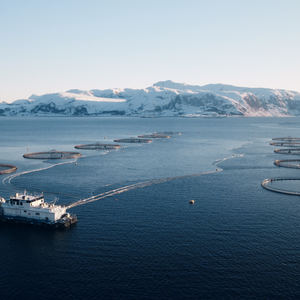Together with colleagues and the Feed Technology Centre in Bergen, Katerina Kousoulaki in Nofima has tested algae meal from heterotrophic algae in the feed of farmed salmon.(Photo: Jon-Are Berg-Jacobsen © Nofima)
Fish oil is an ideal source of omega-3 in salmon feed, but the capacity to produce farmed salmon using fish oil as the main source of omega-3 in feed is limited, if the farmed salmon itself is to remain a rich source of omega-3. This means that the salmon feed industry needs access to large volumes of new ingredients that contain omega-3. Experiments at Nofima have shown that a type of algae known as “heterotrophic algae” can fully replace fish oil in feed used for small salmon.
“We need further sources of omega-3, and heterotrophic algae are one of very few real possibilities at the moment. The algae meal that we have tested contains nutrients that salmon need. We have managed to release and preserve the important nutrients through the process of manufacturing the feed, and this is a necessary condition for the use of this ingredient,” says scientist Katerina Kousoulaki.
Kousoulaki works at the food research institute Nofima and, together with colleagues and the Feed Technology Centre in Bergen, has tested algae meal from heterotrophic algae in the feed of farmed salmon.
Algae that grow in the dark
Heterotrophic algae are single-celled algae that grow using oxygen and a source of carbon (such as plant by-products). Biomass from heterotrophic algae can be produced in a stable manner, in sterile conditions and in large quantities. Current technology allows heterotrophic algae to be produced far more efficiently than phototrophic algae, which grow using light and CO2.
SINTEF has shown that heterotrophic algae such as the one tested by Nofima can be produced at a density of 160-180 gram dry weight per litre of culture, while phototrophic algae can be produced at up to 1-4 gram dry weight per litre. This means that much less space is needed. Furthermore, the productivity for heterotrophic algae is approximately 10 gram/l when grown in large reactors, while it is 0.06 gram/l for phototrophic algae.
Nofima has been commissioned by Alltech, one of the largest companies in the world in the field of animal health and nutrition, to test one of its algae meals. The alga in this meal is a member of the Schizochytrium family, and is extremely rich in omega-3. More than a quarter of the fat in algae is the healthy marine omega-3 fatty acid DHA, which is up to three times more than in fish oil. The alga meal is now being produced commercially by Alltech in the US. The algae have not been subject to gene modification.
As good as fish oil
Nofima has tested how the algae meal affects salmon health, performance, and nutrition.
The normal content of fish oil in commercial feed is around 11%. The meal was added to salmon feed at levels of 0 (control), 1%, 6% and 15% of the feed. The amount of fish oil in the feed was correspondingly reduced, from 15% to 0%. Hence the feed with 15% algae meal contained no fish oil. The alga-based feed was given to small salmon weighing approximately 200 grams in ponds for 12 weeks. All fish had more than tripled their weight at the end of this period, irrespective of the feed they had received.
The salmon increased their intake of food when it contained algae, which suggests that the algae does not inhibit appetite.
The amount of the long-chained marine omega-3 fatty acids in the fillets was higher in salmon that had received the algae meal than it was in salmon that had been given fish oil as their only source of these fatty acids. The digestibility of protein was equal in all feeds, and the digestibility of fat was highest for the feed with 1% algae meal.
Micromatrix analysis shows the activities of thousands of genes at the same time, and is considered to be a reliable measurement method for effects on health. These analyses showed that the feeds did not have any negative effects on health.
Palm oil now unnecessary
Nofima has also studied whether the algae meal is suitable for ensuring a high technical fillet quality of the salmon.
Salmon fillets from fish given feed that contained algae were just as good as those from fish given exclusively fish oil. The texture of the fillets, for example, was just as firm, as was also drainage of water. The amount of gaping in the fillets was also the same.
The algae meal has a high content of short-chain saturated fatty acids, and it is precisely these fatty acids that make palm oil suitable as a technical stabiliser in fish feed. Thus, the composition of the fat in this algae meal makes it unnecessary to use palm oil as a stabiliser.
Complete replacement for fish oil in salmon smolt feed
We can conclude that this algae meal is an excellent source of omega-3 for small salmon, and that it can replace fish oil, based on current levels in feed.
Nofima is now continuing at the Feed Technology Centre in Bergen with optimising the algae meal in feed and improving the way in which it is processed. The algae meal is also to be tested in trials as a possible whole-life feed for salmon.
Nofima signed a collaboration agreement with Alltech in 2012, covering work with alternative sources of feed. The collaboration is particularly focused onto the use of microalgae in fish feed, and the work presented here is one result of the collaboration.



